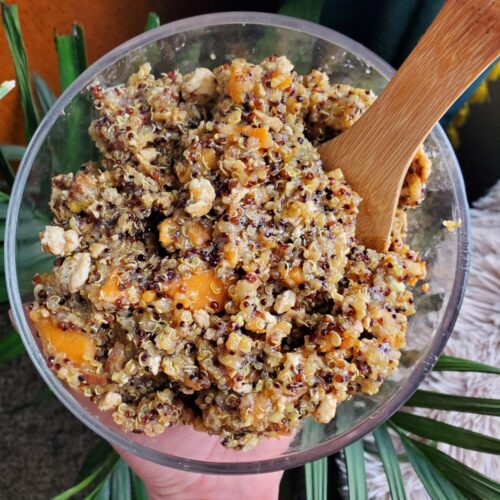
Quinoa w/ Sweet Potatoes, Rice Vinegar, & Tamari
This Japanese quinoa takes inspiration from both Latin American and Asian flavor profiles for a perfect mix of quinoa, sweet potatoes, tamari, rice vinegar, and tofu. It's incredibly simple to throw together in a pinch and eat as a main course, side dish, or component of another meal. I'm rather partial to eating quinoa as the entrée the first day and then wrapping it in a burrito or scrambling eggs on top for a breakfast salad.
Equipment
- Rice Cooker
- Skillet
- Stovetop
- Paper Towels
Ingredients
- 1 sweet potato diced
- 1/2 tsp. turmeric minced
- 1 tsp. ginger minced
- 2 cloves garlic minced
- 1/4 c. rice vinegar
- 1/4 c. tamari (or soy sauce of choice)
- 1 c. tri-colored quinoa
- 2 ½ c. water
- 16 oz. silken tofu (1 package)
- 1 tbsp. high heat oil
- dash salt
- dash pepper
Instructions
Cook Quinoa
- Add sweet potato, turmeric, ginger, garlic, rice vinegar, tamari, quinoa, and water to a rice cooker.
- Press the cook button on the rice cooker. While quinoa is not rice, it does cook the same and oftentimes better than rice in a rice cooker. It typically takes 30-45 minutes. Alternatively you can simmer on the stove. Add all of the ingredients to a pot, bring uncovered to a boil, lower heat to a simmer, and cook for about 15 minutes, or until the sweet potatoes and quinoa are tender. Stir occasionally and test often. Turn off heat, add lid, and let sit another 5-10 minutes.
Fry Tofu
- While the quinoa is cooking, drain the water out of the tofu.
- Wrap in paper towels to absorb the moisture.It's important to absorb as much water out of the tofu as you can. Oil is less dense than water, so the molecules repel one another. With cold ingredients, this causes separation. When you're frying at high temperatures, though, this can cause boiling hot oil to spray back at you.
- Meanwhile, preheat oil in a cast iron skillet over medium-high heat.
- When the skillet has preheated and the majority of the water has absorbed into the paper towels, carefully add the tofu to the skillet. Move them around gently with a spatula, making sure that they cook evenly. The tofu will break apart and cook just like how you would scrambled eggs. Continue to gently move the eggs around until golden brown. This should take about 4-6 minutes.
- Remove from heat and wrap again in paper towels to absorb the excess oil.
Finish Quinoa
- When the quinoa is fully cooked, add tofu and salt and pepper to taste. Fluff with a wooden spoon and serve immediately or chill. Do not use a fork or other metal utensil to fluff! It will scratch off the nonstick surface on the rice cooker. This will leach teflon into your food and cause future dishes to stick to the bottom.
Tips, Tricks, & Notes
- I used Fresh Turmeric in Olive Oil. You can easily substitute dried turmeric. But there is something particularly refreshing about fresh turmeric! And, if you can find it, mincing it and preserving in olive oil is the key to longevity.
- While quinoa is not rice, it does cook the same and oftentimes better than rice in a rice cooker. For more tips and tricks to rice cooker quinoa, check out my article on The Fundamentals of Making Quinoa, including a stovetop version if you don't have or don't want to use a rice cooker.
- I also tend to prefer tamari over soy sauce. They're both made from fermented soy and a lot of recipes use them interchangeably. Tamari tends to have a richer flavor and less salt content. It also tends to be gluten free.
- For a more in-depth article on preparing tofu, check out my article on The Fundamentals of Fried Tofu. High heat oil and a precise cooking temperature are important to keep the tofu from drying out or burning.